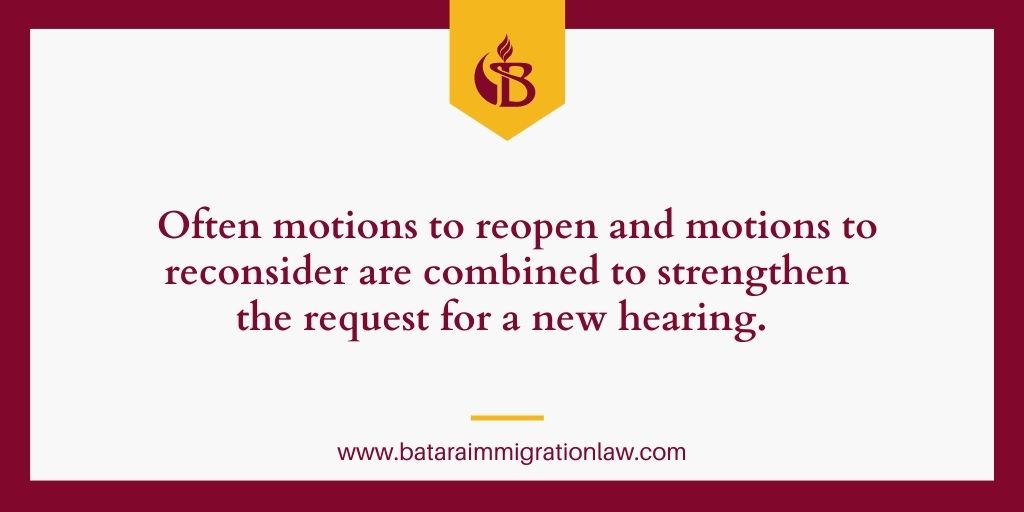
When is a loss at immigration court not a loss?
When you disagree with the decision and you challenge the ruling.
Snatching Victory From The Jaws Of Defeat At Immigration Court
After an immigration removal hearing has ended, immigrants have the right to contest a judge’s decision to deny them relief and order their deportation. The most common route is to file an immigration appeal.
However, filing an appeal is not always your best approach to starting over.
In some cases, your situation would be better served by filing an EOIR motion to reopen or a EOIR motion to reconsider your case.
(EOIR stands for Executive Office For Immigration Review, the formal name for the immigration court system.)
Of course, technically speaking, motions to reopen and motions to reconsider are a form of “appeal”.
Let’s take a closer look at these motions.
Table Of Contents
- What Is A Motion To Reopen At Immigration Court?
- When Can Motions To Reopen At Immigration Court Be Filed?
- Are There Time Limits For Filing Motions To Reopen?
- Does Filing A Motion To Reopen Prevent Deportation And Removal?
- What Happens When An Immigration Court Motion To Reopen Is Granted?
- Differences Between Immigration Court Motions To Reopen And Motions To Reconsider
- What Is A Motion To Reconsider At Immigration Court?
- When Should Motions To Reconsider At Immigration Court Be Filed?
- What Are The Time Limits For Filing A Motion To Reconsider?
- Does Filing A Motion To Reconsider At Immigration Court Prevent Deportation And Removal?
- What Happens When An Immigration Court Motion For Reconsideration Is Granted?
- Conclusion: Two Ways To Challenge Defeat At Immigration Court

What Is A Motion To Reopen
At Immigration Court?
A motion to reopen is a request after an adverse decision has been made – a deportation order has been issued by an Immigration Judge or the Board of Immigration Appeals.
The motion asks the immigration court to consider previously unavailable evidence. If the motion is granted, the existing order is vacated.
When Can Motions To Reopen At Immigration Court Be Filed?
There are three situations which may allow you to file a motion to reopen at immigration court, giving you a second chance to win your deportation case.
1. In Absentia Order Of Deportation
If you miss a hearing at immigration court, the immigration will order you to be deported in your absence. This is called an in absentia deportation order.
Sometimes immigrants fail to show up at immigration court because they never received the notice of the hearing date. For example, maybe the government’s letter was mailed to the wrong address. Perhaps you moved and gave your new address to the immigration court, but the judge’s secretary sent the notice to your old address.
2. New Evidence Or Circumstances
It is not uncommon at the close of removal proceedings, after the immigration judge has ordered an immigrant to be deported, new information emerges. This evidence can open the door for you to seek relief from deportation if it did not exist at the time of your immigration trial.
This is not as simple as it appears. The Immigration Court Practice Manual, which sets forth the guidlines for immigration court motions, makes clear that you have to prove the new evidence could not have been discovered and presented at your earlier hearing. This is referred to as acting with due diligence.
If you knew – or should have know about the evidence – but you did not take any action, you are not entitled to use this reason as the basis for a motion to reopen.
3. Exceptional Circumstances
With these types of reopening motions, you have to show something exceptional, beyond your control, kept you from showing up at your hearing. For instance, maybe you became seriously ill, a family member died. or you had a car accident on the way to court.
None of these reasons guarantee your case will be reopened. But if you’re fighting against being deported, filing a motion to reopen may give you a second chance to win your case.
As a result of judicial preference for case finality, immigration judges are not inclined to grant these motions. As a result, given the rigid due diligence requirements, winning such EOIR motions is not a simple.
Are There Time Limits For Filing
Motions To Reopen?
In general, immigration court motions to reopen must be filed within 90 days of the final court decision or deportation order.
There are a few exceptions.
- If you were issued an in absentia order of removal but your absence from court that day was caused by exceptional circumstances – i.e., you were hospitalized – you are given 180 to file your motion.
- If your case involved seeking asylum protection, and your home country has recently experienced changed conditions since your last hearing, there is no time limit to file a motion to reopen.
- Likewise, if your case involved a claim for relief under cancellation of removal under the violence against women provisions, there is no time limit for filing.
- Or if the government attorney agrees with your request to file a motion to reopen, and agrees to filing a joint motion to reopen, there is no time limit on filing your motion.

There is also an exception – called “equitable tolling” – if you were prevented from filing a immigration court motion to reopen due to deception fraud, or error. Again, if you knew or should have known what was occurring, but did not take any action to correct such problems, you are not eligible to claim equitable tolling to excuse your late filing.
Reopening claims based on the ineffective assistance of an previous attorney, referred to as Lozada motions, if successful, enable equitable tolling. Essentially, immigrants must show that not only their prior lawyer failed to adequately represent them, but also their case was prejudiced by the flawed assistance.
Does Filing A Motion To Reopen Prevent Deportation And Removal?
While you are waiting for a decision on your EOIR motion to reopen, you can still be deported. In other words, the order to remove you from the United States remains in effect.
There is one caveat. If your request for reopening pertains to a removal court order that was made in absentia, the order is temporary “stayed” – meaning the order is temporarily halted until the immigration court makes a decision. If you lose your motion to reopen, the deportation order is reinstated.
What Happens When An Immigration Court Motion To Reopen Is Granted?
If your motion is granted, the judge will allow you to present your case. A new decision will be issued after you are given a new day in court, and the judge evaluates the law or facts it failed to consider in the earlier proceedings.
Even when your motion is granted, it does not guarantee the result in your case will be reversed. However, it will give you a second chance to present your case in full and the opportunity for success.
Differences Between Immigration Court Motions To Reopen And Motions To Reconsider
Many clients confuse EOIR motions to reopen with EOIR motions to reconsider. Although similar in effect, there are major distinctions.
Immigration court motions to reopen are based on factual grounds. Primarily, these motions are centered upon the discovery of new evidence or changed circumstances.
On the other hand, immigration court motions to reconsider are based on legal grounds. These motions focus on errors in the application of law, policy, or procedure made by the immigration judge, leading to a negative court decision.

The two types of motions are not incompatible. Often immigration court motions to reopen and motions to reconsider are combined.
Even though each type of EOIR motion is assessed separately, combining them can strengthen the request for a new deportation hearing.
(Editor’s Note: Motions to reopen and motions to reconsider are also quite common in permanent resident cases before the U.S. Citizenship and Immigration Services. Even though these motions are quite similar in nature to those filed at immigration court, there are procedural differences for USCIS motions when your green card case is denied by the government agency, and not by the immigration court.)
What Is A Motion To Reconsider At Immigration Court?
Likewise, a motion to reconsider is a request after an adverse decision has been made – a deportation order has been issued by an Immigration Judge or the Board of Immigration Appeals.
The motion asks the immigration court to re-examine the legal standards used as the basis of its’ decision. If the motion is granted, the existing order might be revised.
When Should Motions To Reconsider At Immigration Court Be Filed?
In contrast to motions to reopen, immigration court motions to reconsider are based on legal grounds, seeking a new evaluation based of errors of law, fact, or policy.
Here are three common reasons that might lead to a reversal of the court’s original opinion.
1. Exclusion Of Relevant Evidence
Sometimes, immigration judges overlook the significance of evidence critical to an immigrant’s defense. This has become more common over the past decade due to the increasing size of the court’s backlog.
With too many cases for them to handle adequately, many tend to minimize various issues that, in their view, are less likely to raise important, yet less, obvious factors supporting an immigrant’s claim for relief.
For instance, take an immigrant involved in a hostile divorce proceeding with his U.S. spouse. Based on her claims, the family law court issues a temporary restraining order against the immigrant. While that battle is ongoing, the immigrant has a merits hearing at immigration court. The government attorney attacks the immigrant’s good moral character record, emphasizing the domestic violence allegations.
The judge incorporated and highlights the restraining order allegations in his decision to deny the immigrant’s claim for relief. A few weeks later, the family law court finds the wife’s allegations were unfounded and unsubstantiated.
Denial Of Legal Rights
Immigrants are entitled to due process. This means that their hearings and trials must comport with our notions of fundamental fairness.
One such problem that can arise is the assistance of a competent translator at hearings. Because a large percentage of cases require an interpreter, the immigration court at times has problems finding persons who can translate for someone in their native language.
In such instances, the judge may utilize an interpreter who speaks a language close to the immigrant’s dialect. This can and does lead to difficulties between the interpreter and the immigrant or other supporting witness. Questions may not be understood sufficiently, causing the immigrant’s testimony to appear less credible or authentic in the judge’s view.
Again, the judge’s propensity to push removal cases to completion would constitute the basis for the filing of a motion for reconsideration.
Failure To Properly Apply Existing Law
All courts are bound to follow the precedent of previous cases, as well as statutory regulations. In some cases, a novel approach to a rule leads to an argument over which application of a rule applies to the matter under review. Such disagreements are usually the basis for filing an immigration appeal with a higher court.
Because an EOIR motion to reconsider rests upon existing evidence, it is not properly used to introduce new facts, evidence, or interpretations of law.
On the other hand, when a judge fails to apply existing laws properly, that is a valid rationale for filing motions for reconsideration.
Consider, for example, an immigration court that refused to consider the testimony of an immigrant’s step-children in a non-LPR cancellation of removal case. As long as the step-children are either permanent residents or U.S. citizens, excluding their testimony is an improper application of existing law.
What Are The Time Limits For Filing A Motion To Reconsider?
Unlike motions to reopen, immigration court motions to reconsider are limited to 30 days from the date of the judge’s decision.
Does Filing A Motion To Reconsider At Immigration Court Prevent Deportation And Removal?
Similar to a motion to reopen, a motion to reconsider at immigration court does not automatically stay a removal order. The judge’s order of deportation remains in effect.
In addition, if an immigrant has agreed to voluntary departure, rather than being issued a deportation order, filing a motion to reconsider will negate the agreement and terminate the voluntary departure grant.
What Happens When An Immigration Court Motion For Reconsideration Is Granted?
A motion to reconsider at immigration court is vastly different from a motion to reopen.
If a reconsideration motion is granted, the decision is not vacated. Instead, the court retains jurisdiction over the case. The court will decide the case again, but it will take into account all the facts and laws that it mistakenly failed to weigh the first time.
As a result, the end result may not change. In short, the case will be re-decided, with the corrected attention paid to the errors. Yet. even after the reevaluation, the final ruling may end up the same.
Conclusion: Two Ways To Challenge Defeat At Immigration Court
When you believe a wrongful decision by a judge has been issued, immigration court motions to reopen and immigration court motions to reconsider offer two distinct ways to get your case back on track. Such objections should not be undertaken lightly.
These motions will not be granted simply because you disagree with the court case outcome.
They offer a second chance to win, but not a second bite of the same apple. Immigration judges are too busy already without being bothered by frivolous filings and are not likely to be happy when told they were wrong.
Both EOIR motions are built upon the concept of judicial economy. This means that judges should be given the chance to fix its errors as soon as possible, and prior to entry of a final judgment.
The key, in both motions, is to demonstrate that substantial injustice will occur absent judicial corrections. When presented properly, you’ll be able to seize the moment to get your case back on track for potential success.
Ready to take a serious and honest look at the strengths and weaknesses of your immigration case? Let’s get started with a personalized strategy and planning session . . .




